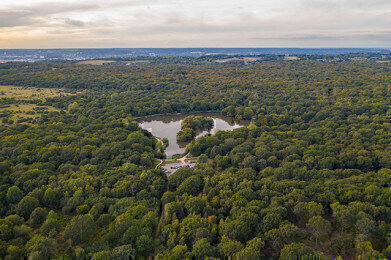Air Monitoring
Protecting Air Quality in Special Areas of Conservation
Sep 22 2020
Katherine Johnson a leading environmental engineer from, Idom Merebrook considers the growing tension between the need for infrastructure development, and ensuring prudent measures in air quality control are taken, within the UK's most fragile environments.
Public health issues surrounding air quality have been on the environmental agenda for many years, with the issue becoming even more significant this year. Air pollution is widely evidenced to have a direct, negative impact upon health contributing to heart disease, strokes, lung disease and cancer.
However, an ever-growing population demands an infrastructure that accommodates all aspects of modern living. The need for development in some areas of the UK is in direct conflict with the need to protect the environment and maintain clean air.
In recent years, the planning departments of local authorities and council chambers have become something of a battleground - the territory where opposing forces of development and conservation come to loggerheads.
In Britain, the main threat to nature conservation sites in terms of air pollution is as a result of elevated ambient concentrations of oxides of nitrogen (NOx) and ammonia (NH3).
Both NOx and NH3 contribute to nitrogen deposition, which can lead to acidification of soils and loss of species diversity, as well as increasing the risk of damage from frost, drought and pests.
Road transport emissions are a major contributor to air pollution problems at protected sites, particularly where major roads run through, or in close proximity to threatened habitats.
Heathland habitats, including heather, lichens and mosses, are particularly sensitive to air pollution. Elevated levels of nitrogen encourage the growth of nitrophilic species such as grasses and bracken, which competitively exclude the heath species over time due to shading or competition for other limited resources.
Katherine commented:
"Background concentrations and nitrogen deposition rates are elevated across much of the UK. Around 80 % of SACs in England by area are estimated to receive damaging amounts of atmospheric nitrogen.
Recently, Idom Merebrook has been involved in an environmental project in Epping Forest, which has proved to be an important example of a protected site battling with historical and on-going air pollution."
Epping Forest was designated as a Special Area of Conservation (SAC) under the Conservation of Habitats and Species Regulations 2017, due to the presence of beech woodland and heathland. The forest supports over 80% of the UK's ancient beech trees, many of which are in excess of 500 years old.
Recent surveys revealed over 60% of the forest is in unfavourable condition and is at a uniquely high risk of adverse environmental impacts, with extremely high background air pollutant levels when compared to other protected sites in Southeast England.
The continuing high levels of air pollution mean that the forest is highly vulnerable to additional threats such as the increase in traffic emissions, associated with future development plans outlined by Epping Forest District Council.
Katherine continued:
"Applicants for new schemes which will increase emissions in the vicinity of protected sites are finding it increasingly difficult to prove that their plans will not exacerbate the existing problems".
Under the Habitats Regulations, the applicant is required to prove that the proposal will not adversely affect the integrity of the protected site in question. However, an underlying principal in the Habitats Directive is the precautionary principle.
This means that where it cannot be evidenced that there will be no adverse effects on the integrity on the protected site, it must be assumed that adverse effects may occur.
Another example where the issue of infrastructure development versus air quality has arisen is in East Sussex. A planning application was made for the Mornings Mill Farm site at Polegate for a mixed-use, urban extension including up to 700 dwellings, 8,600 square metres of employment space, a medical centre, primary school, community centre, retail, playing fields, children's play space, allotments and amenity open space.
The applicant lodged an appeal due to non-determination of the application at which point Wealden District Council cited intensification of nitrogen deposition as a result of the additional traffic as a reason for refusal. The appeal scheme progressed to public inquiry but was later refused on highways grounds.
Katherine added:
"In sensitive locations where development is essential to address local housing needs, mitigation is key.
There are established solutions for mitigating the recreational pressures on protected sites associated with new developments. However, mitigation for air quality presents more of a challenge".
For proposed residential schemes, where the greatest potential impacts are associated with increased traffic emissions, there is limited potential for directly mitigating impacts within the design of individual developments with any degree of certainty.
Typically planning applications propose a range of ‘soft measures' as part of a travel plan which encourage the uptake of low-emissions vehicles (for example by providing electric vehicle charging infrastructure) and aim to reduce reliance on private car travel by encouraging walking, cycling and use of public transport.
The greater potential for implementation of effective mitigation would seem to be development contributions to fund more strategic measures to reduce emissions and overall traffic volumes along affected routes.
The Government's Clean Air Strategy[1] released last year aims to reduce emissions from a diverse range of sources including transport, farming and industry. If successful this will help to reduce nitrogen deposition on protected sites.
With renewed focus on a green restart for the country, we hope to see the Clean Air Strategy play a fundamental role in the development plans to protect the nation's health, the environment and secure clean growth for the economy."
Digital Edition
IET 34.2 March 2024
April 2024
Gas Detection - Biogas batch fermentation system for laboratory use with automatic gas analysis in real time Water/Wastewater - Upcycling sensors for sustainable nature management - Prist...
View all digital editions
Events
Apr 30 2024 Melbourne, Australia
Apr 30 2024 Birmingham, UK
May 03 2024 Seoul, South Korea
May 05 2024 Seville, Spain
May 06 2024 Minneapolis, MN, USA



















